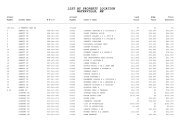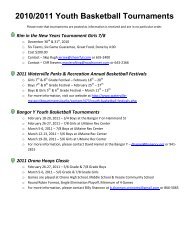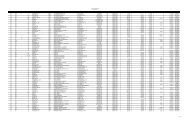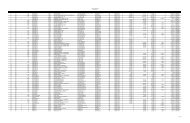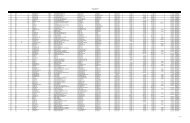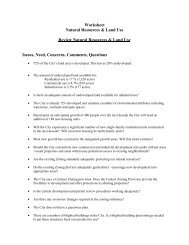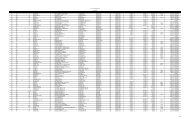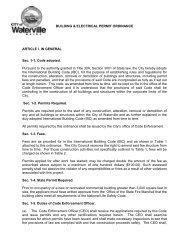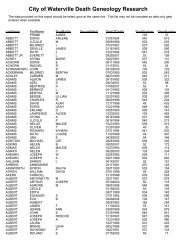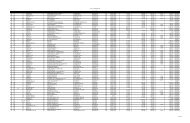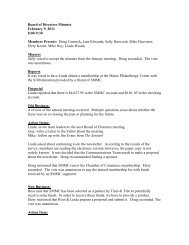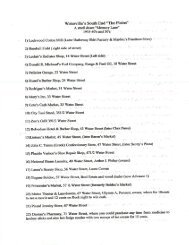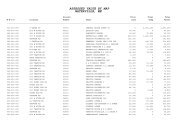Airport Master Plan 2012 - City of Waterville
Airport Master Plan 2012 - City of Waterville
Airport Master Plan 2012 - City of Waterville
You also want an ePaper? Increase the reach of your titles
YUMPU automatically turns print PDFs into web optimized ePapers that Google loves.
China Lake as its sole source <strong>of</strong> supply. It filters and treats the China Lake water in its Vassalboro<br />
filtration facility, a state-<strong>of</strong>-the-art plant placed online in August 1993.<br />
For purposes <strong>of</strong> previous stormwater management analyses, four watersheds were identified within the<br />
<strong>Airport</strong> property. 5 Run<strong>of</strong>f from three <strong>of</strong> the watersheds on the site (Watersheds 2, 3 and 4) is directed to<br />
the southeast via a series <strong>of</strong> drainage-ways within the southeastern portion <strong>of</strong> the site. Stream flow enters<br />
the Lower Kennebec River approximately 6,000 feet southeast <strong>of</strong> the <strong>Airport</strong>. The Lower Kennebec<br />
River is a sensitive and threatened watershed. 6 Watershed 1, contains the business park and the northwest<br />
portion <strong>of</strong> the <strong>Airport</strong>. Run<strong>of</strong>f within Watershed 1 enters a stream channel which flows north to south<br />
within the western portion <strong>of</strong> the site and also later joins the Lower Kennebec River.<br />
In 2004, permit requirements for upgrades to the <strong>Airport</strong> apron and automobile parking lot required the<br />
removal <strong>of</strong> at least 40% <strong>of</strong> the total suspended solids (TSS) in stormwater run<strong>of</strong>f to meet the sliding scale<br />
TSS standard. These improvements also involved the use <strong>of</strong> dry swales to reduce the water temperature<br />
<strong>of</strong> run<strong>of</strong>f by passing it through solid filters and undergrounds drain lines. This is intended to help prevent<br />
the run<strong>of</strong>f from having any thermal impact <strong>of</strong> the small brook draining to the Lower Kennebec River.<br />
Groundwater<br />
The <strong>Airport</strong> and the <strong>Airport</strong> Business Park are situated in an area with moderate to low or no potential<br />
groundwater yield and are not located over or near any mapped sand and gravel aquifer which could be<br />
utilized as a municipal groundwater supply. All current and future development at the <strong>Airport</strong> will utilize<br />
municipal water supply and wastewater disposal systems. Small quantities <strong>of</strong> petroleum products or other<br />
potential groundwater contaminants are stored within the T-hangar or cube hangar units 7 . The hangars<br />
are built upon concrete slabs and no floor drains are present. The fueling facility at the <strong>Airport</strong> is<br />
addressed in a revised Spill Prevention Control and Countermeasure (SPCC) <strong>Plan</strong> (see Fuel Storage).<br />
Topography and Geology<br />
The <strong>Airport</strong> and the <strong>Airport</strong> Business Park are situated on a hill comprised <strong>of</strong> glacial till with moderate to<br />
low or no potential groundwater yield. The surficial material underlying the <strong>Airport</strong> property is<br />
designated as Qt (till) which is heterogeneous mixture <strong>of</strong> sand, silt, clay and stones that generally overlies<br />
bedrock or sand and gravel. The property is primarily comprised <strong>of</strong> upland soils formed in firm stony<br />
glacial till including Woodbridge fine sandy Loam, Hollis fine sandy loam, Paxton-Charlton fine sandy<br />
loam and Scio very fine sandy loam. Wetland areas within the property are mapped as poorly drained<br />
Scantic silt loam and Ridgebury fine sandy loam. The extent <strong>of</strong> the hydric soils will be better refined<br />
during future detailed wetland delineations. Future stormwater management structures will involve the<br />
drainage classification and percolation rate <strong>of</strong> the soil, and the siting <strong>of</strong> structures will involve the loading<br />
capability <strong>of</strong> the soils.<br />
Bedrock mapping within the vicinity <strong>of</strong> the <strong>Airport</strong> includes stratified rock <strong>of</strong> the Silurian age,<br />
specifically the <strong>Waterville</strong> Formation (Sw), the Sangerville Formation (Ss), and an unnamed sulfidic<br />
pelite (Sur).<br />
5<br />
Application for Permit Modification. March, 2004. Prepared by Dufresne-Henry, Inc.<br />
6<br />
State <strong>of</strong> Maine Department <strong>of</strong> Environmental Protection SLDA Permit No. L-8253-18-I-M. Page 3 <strong>of</strong> 7.<br />
7<br />
Spill Prevention Control and Countermeasure <strong>Plan</strong>. <strong>Waterville</strong> Robert Lafleur <strong>Airport</strong>. August 2006. Prepared by Stantec Consulting<br />
Services Inc.<br />
The <strong>City</strong> <strong>of</strong> <strong>Waterville</strong> Maine<br />
Baseline Conditions – Page 1-18<br />
<strong>Airport</strong> Solutions Group, LLC & The Louis Berger Group, Inc. December 2011



